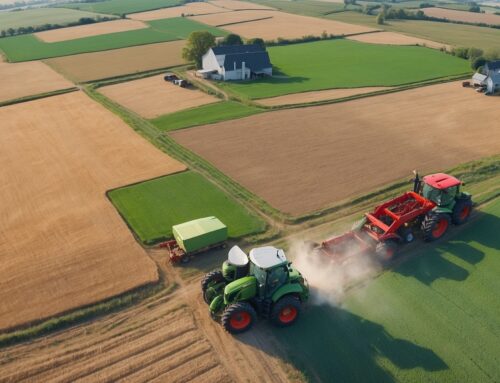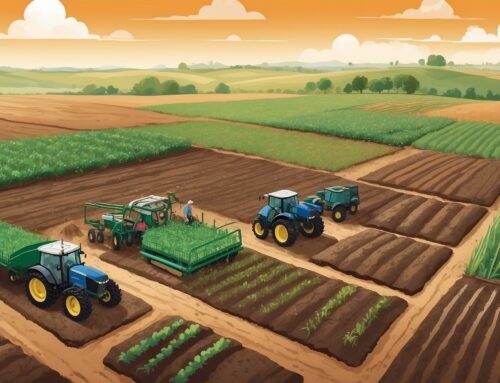Howdy there, fellow farmers! You ever wish you could talk to your tractor, your soil sensors, and your weather station all at once—maybe like a real barnyard council meeting? Well, thanks to the wonders of modern technology, we’re just about there. Today, let’s chat about one of the less glamorous, but oh-so-crucial, parts of precision agriculture: reliable connectivity.
If you’ve ever tried to get a signal out in the farthest part of your field, you know the frustration. There’s nothing quite like standing on a fence post, waving your phone around, hoping for one bar of reception—like some kind of cowboy summoning rain, but for Wi-Fi. But reliable connectivity, whether it’s through cellular networks, LoRaWAN, or good ol’ satellite internet, is what makes all these fancy gadgets and tools work together like a well-oiled machine. So let’s dive in and see why connectivity is the backbone of precision agriculture.
Connectivity: The Secret Sauce of Smart Farming
In a world where everything’s getting smarter—smartphones, smart TVs, even smart fridges that’ll remind you when you’re out of milk—why not smart farming? All the gadgets and gizmos we use, like soil moisture sensors, remote-controlled irrigation systems, and autonomous tractors, are only as smart as the connections they rely on. It’s like having a well-trained sheepdog—but if the dog can’t hear your whistle, it’s just a dog sniffing around in the dirt.
With good connectivity, your IoT devices can talk to each other in real-time. Your soil moisture sensor says, “Hey, things are getting a little dry over here,” and your irrigation system can answer, “No worries, I’ll get some water on that.” It’s like a farm full of little helpers, all working together without you needing to step in every time—assuming, of course, that they’ve got a good connection.
The Different Flavors of Connectivity
Now, just like how there’s more than one way to cook an egg, there’s more than one way to get your farm connected. Each has its own pros and cons, and sometimes, it’s a bit of a mix-and-match to find the right solution.
Cellular Networks
If you’re lucky enough to have good cell coverage in your area (and not just when you stand on that one hill at sunset), then cellular networks can be a great option. They’re fast, reliable, and can handle a lot of data. It’s like having a direct line to the barnyard gossip—you’re always in the loop. The downside? Not every field is close enough to a tower, and roaming charges can pile up faster than a load of manure if you’re not careful.
LoRaWAN
If you’ve never heard of LoRaWAN, you’re not alone. It’s a type of long-range, low-power network that’s perfect for sending small packets of data over large distances—kind of like how a rooster’s crow can be heard all over the farmyard. LoRaWAN is great for soil moisture sensors and other devices that don’t need to send a lot of information but need to keep in touch regularly. Plus, it’s more affordable and doesn’t rely on cell towers. The catch? It’s not for streaming movies—it’s more like sending a postcard from your soil sensors to your dashboard.
Satellite Internet
If you’re farming in the middle of nowhere—and let’s be honest, a lot of us are—then satellite internet might be your best bet. It’ll get you connected where nothing else will, from the back 40 all the way to that corner you swear is haunted. But satellite can be pricey, and there’s often a bit of lag, which means your autonomous tractor might have a “mind of its own” for a second or two. Still, it’s a small price to pay when you’re farming out where even the coyotes get lost.
Why Connectivity Matters
You might be thinking, “Why all the fuss about connectivity? My grandpa farmed without any of this, and he did just fine!” And you’d be right—but times are changing, and the challenges we’re facing today are different. With the cost of water, fertilizers, and diesel going up, and with everyone asking us to produce more with less, we need every advantage we can get. Reliable connectivity is what turns our data into action.
For example, with connectivity, your weather station can update your irrigation schedule automatically when it detects a sudden change—so you’re not out there turning valves when you could be inside having dinner. It also means you can use real-time monitoring to catch issues before they become big problems—like noticing a sensor reading that’s gone wonky and fixing it before you end up overwatering half the field.
And let’s not forget about remote management. Being able to check your farm’s vitals from your phone while you’re at the market or on a much-needed weekend away? Now that’s priceless. It’s like being able to keep an eye on the herd without ever leaving your front porch.
Connectivity Challenges: The Real Dirt
Of course, there are challenges. Sometimes those signals just don’t want to cooperate—like stubborn cattle that won’t go through the gate. Bad weather, geography, and even the number of devices can make things tricky. But that’s why we’re seeing so many different options and solutions pop up—and why it’s important to have a connectivity plan that’s as adaptable as we farmers are.
At the end of the day, having good connectivity is what takes all the amazing tech we have at our fingertips and makes it work like it’s supposed to. Whether it’s a simple soil sensor or an entire fleet of autonomous machinery, reliable connections keep everything in sync, making farming a bit more predictable, a bit more efficient, and (hopefully) a lot less stressful.
From Barnyard to Broadband
So, here’s to embracing connectivity—from the barnyard to broadband, from fence post to fiber optics. It might not be as exciting as a new piece of machinery, but it’s just as crucial. Because, let’s face it, when all your farm gadgets are chatting away in perfect harmony, it’s a beautiful thing. And hey, maybe someday we’ll even get those cows connected—though I’m not sure I’m ready for them to have an opinion on everything.
Until then, happy farming, and may your signal bars be as full as your harvest!





